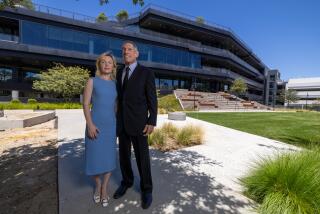Licensing Seen as Key to Biomedicine’s Rise : Research: UCI’s planned center can help expand the industry, public officials and business leaders agree.
IRVINE — Only with the right research and licensing agreements can UC Irvine’s planned biomedical research center help expand that industry in Orange County, public officials and business people agreed at a hearing Thursday.
Chaired by state Sen. Marian Bergeson (R-Newport Beach), the morning session in the Irvine City Council’s chambers drew several dozen company officials for a discussion of the role the research center might play in creating companies and jobs and how state government could encourage such growth.
Speakers said academics and company executives must understand each other better to develop marketable products quickly from research.
For example, academics tend not to think about the patent potential of basic research, said Dr. Michael Selsted, associate vice chancellor for research and graduate study at the university.
But “if there isn’t patent protection on a product, you can’t attract investors,” he said. “The first thing people say to us when they’re talking about licensing a product for their company is, ‘Has a patent been applied for?’ ”
For their part, some company officials said they must get better at imagining the commercial uses of new technologies.
“We’ve licensed things from UCI before, but we tend not to do it because it’s difficult” to obtain full commercial protections on publicly funded research, said W. Charles Johnson, a scientific officer with Fullerton-based Beckman Instruments Inc.
The biomedical companies’ heavy reliance on university research makes schools central to the development of a regional industry. In California, Orange County competes with San Diego and the San Francisco Bay Area for biomedical companies and jobs, and planners hope the proposed UCI center will advance this county’s position as defense-manufacturing jobs decline.
“Companies follow universities,” said David Anast, a local industry analyst. The UCI center will work especially well if its research focuses on products that can be manufactured easily, he said.
*
Anast, who publishes an industry newsletter, said he counted about a thousand medical manufacturers in Orange County in a recent survey. Of those, about a hundred make biological or pharmaceutical products; the others make biomedical products, particularly medical equipment and instruments.
Construction on the first building in UCI’s Center for the Health Sciences is scheduled to begin in January. Dr. Thomas Cesario, acting dean of the UCI College of Medicine, said the university hopes to have 10 buildings on the 43-acre site and that a private-sector research park will grow on an adjacent 250-acre site.
Half of the funding for the first building, a $22-million neuroscience research center, will be provided by state bonds. UCI’s medical school is contributing $6 million, and $1 million was bequeathed by a faculty member. UCI is still trying to raise the remaining $4 million to complete the building, a spokeswoman said. There are no plans to fund the other buildings yet, she said.
Orange County’s biomedical industry is sure to lure new companies to fill the research park. Daniel Korpolinski, president and chief executive of Irvine-based Cocensys, said biotechnology companies depend closely on the expertise of others nearby.
Cocensys, which develops and markets drugs to treat conditions such as epilepsy, sleep disorders and head trauma, is itself a spinoff from work done by USC faculty, he said.
Korpolinski said the state could support companies like his by reducing the amount of administrative tasks required to do business.
“We’re overburdened with permits and with forms,” he said. “We’d like to cooperate to help truncate the process” of paperwork.
The state could also help by addressing more general issues such as improving the quality of public education. He said potential employees from out of the state tell him they worry about public education when they think about relocating to California.
Freedom Communications Chief Executive James Rosse, chairman of a committee looking at links between UCI and the business community, said Orange County’s situation reminds him of Silicon Valley’s growth around Stanford University, where he was once provost.
At Stanford, at the height of the boom, he said, “it was sometimes hard to tell who were the academics and who were the entrepreneurs.”
More to Read
Inside the business of entertainment
The Wide Shot brings you news, analysis and insights on everything from streaming wars to production — and what it all means for the future.
You may occasionally receive promotional content from the Los Angeles Times.










